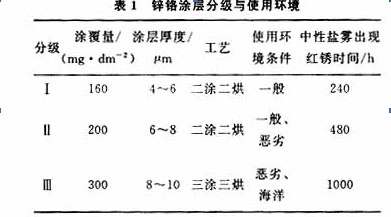行业知识
Dacromet (coating) anti-corrosion new technology
1 Development background of Dacromet coating technology
Dacromet coating technology is called Dacromet in Japan, and zinc-chromium coating technology in the United States and Europe.
Dacromet coating technology was first produced in the United States in the late 1960s. It was originally a protection technology invented to solve the problem that automobile chassis parts were prone to rust when encountering salty rain and snow, threatening the safety of vehicle operation. In the 1970s France, Germany, Italy and other countries in Europe and Japan in the 1980s successively introduced this technology. The successful application of this technology has greatly improved the anti-corrosion performance of iron-based materials. It was first introduced by a domestic airborne equipment factory in the 1990s. This coating technology has been successfully applied to a product in cooperation with Germany.
In the past 5 or 6 years, 22 production lines have been introduced successively in China, which has promoted the Dacromet coating technology, showing the trend of starting a prairie fire.
2 The purpose of introducing Dacromet coating technology
2.1 Improve product quality
Compared with galvanizing technology, Dacromet coating technology is a green technology with good corrosion resistance, no hydrogen embrittlement, and no pollution. The layer is larger than the named military standard MIL-C-87115A, which makes this technology widely used in land, sea and air force equipment.
However, product corrosion has been a long-term problem that has plagued many domestic companies. The product has not yet left the factory, and after the rain test, the screws are rusty and must be replaced before leaving the factory. Even if they were later changed to stainless steel screws, the problem was not fundamentally solved. .
At present, the Equipment Department has instructed troops at all levels to solve the problem of serious equipment corrosion.
2.2 Solve the problem of solder joint corrosion after spot welding and galvanizing of steel structures
Before the introduction of Dacromet technology, spot welding and galvanized protection were used for composite structural parts. The surface quality and product protection were poor. The product is rusted. If galvanized first and then spot welded, the zinc layer at the solder joint will be damaged, and the appearance quality will not be guaranteed. The process department is in a dilemma.
After adopting Dacromet technology, Indacromet coating technology is far away from acid and alkali (plating solution), avoiding corrosion problems. What is more pleasing is that the spot coating of dacromet-coated parts is intact after spot welding, and No burning color. At this point, everything is easily solved.
2.3 Governance environment
Treating the environment with technology is the guiding principle of our technological transformation. Only in this way can pollution be eradicated. In addition to the aforementioned quality problems that cannot be avoided by the traditional galvanizing process, there are problems with the driving of the plant, the power supply equipment, and the instruments, devices and workshop parts of the surrounding departments. Different degrees of corrosion effects.
The semi-automatic galvanizing line established in our factory in the early 1970s took about half a year. The line body and equipment were corroded. One year later, the plant and equipment were seriously corroded. The service life of the power supply is short, the production cost is high, and the environment is harsh, which has a great impact on the health of workers.
Dacromet technology is an acid-free and alkali-free coating technology. It has been proved by the production test in the past year that the introduction of this technology not only greatly improves the product quality, but also plays an important role in the control of environmental pollution.
3 Introduction to Dacromet Technology

3.1 Paint and coating formation
3.1.1 Coatings
Dacromet paint is an inorganic anti-corrosion water-based zinc-chromium paint with zinc and aluminum chromate as the main component. It is a highly dispersed water-based solution. The raw materials it uses are flake zinc and Aluminum powder.
3.1.2 Coating formation
Zinc-chromium slurry is dipped, brushed or sprayed on the surface of iron-based parts or components, and baked at a high temperature of about 320 degrees Celsius to form a complete and strong anti-corrosion layer on the surface to achieve the purpose of protection.
3.2 Anti-corrosion mechanism
The zinc and aluminum flakes used in the Dacromet coating are extremely fine, extremely thin, and highly dispersed. Dozens of dense fish scale-like protective layers are formed in the coating of only 5-8 μm, while there are large and small scales on the surface of the galvanized layer. Different micropores with different depths lead to a significant difference of 7-10 times in the anti-corrosion performance of the two coatings.
3.3 Properties of the coating
It is necessary to promote Dacromet coating to replace zinc coating on military equipment, and it is necessary to compare their performance indicators. For this reason, the military and the military have set up a joint test team to test the salt spray, damp heat, high and low temperature impact of zinc chromium coating, Rapid corrosion, coating and substrate adhesion, coating and paint film adhesion, coating hardness, screen printing, spot weldability, electrical conductivity, stretching, bending, strong fastening of fasteners, etc. The performance is compared with the low-cyanide galvanized test piece. (All test methods and steps are in accordance with the relevant provisions of the national military standard and national standard).
3.3.1 Salt spray resistance
When the thickness of the zinc-chromium coating is 8 μm and the thickness of the galvanizing is 15 μm, the purchased galvanized fasteners exit the test after only 68 hours, and the galvanized fasteners made in the factory have a large area of corrosion products and a large amount of red in 158 hours. corrosion spots, while the zinc-chromium coating specimens did not appear some red rust spots until 1000 hours.
3.3.2 Moisture and heat resistance
At a temperature of 35 degrees Celsius ± 2 degrees Celsius and a humidity of 95 percent, after 10 cycles of 240-hour cycle tests, the surface of the zinc-chromium coating has no change, and there are mildew spots on the surface of the galvanized layer.
3.3.3 High and low temperature impact resistance
At -45 degrees Celsius to 85 degrees Celsius, the samples are kept in the high and low temperature test chamber for 1 hour each, the conversion time does not exceed 5 seconds, and the number of cycles is 3 times. The two coatings have no change.
3.3.4 Bonding force between coating and substrate, bonding force between coating and paint film
Under the above-mentioned humid heat test environment, the binding force between the zinc-chromium coating and the paint film has reached the national first-class and second-level standards, and the binding force between the zinc coating and the substrate is both first-class standards.
At room temperature, the bonding force between the two coatings and the substrate is the national first-class standard.
Under the impact of high and low temperature, the bonding strength of the coating and the paint film of the two kinds of coatings are all national first-class standards.
3.3.5 Hardness
The hardness value of the zinc coating is 75-88HV0.05, and the hardness value of the zinc-chromium coating is 210-232HV0.05.
3.3.6 Spot welding performance
Dacromet coated and then spot welded on the angled parts shows that Dacromet coating has good spot welding performance. From the Dacromet process, the protection of Dacromet after spot welding is better than that of Dacromet. Post-spot welding.
3.3.7 Screen printing
After printing on the dacromet coating, it was observed that the surface font did not fall off after sticking and peeling off with adhesive tape, indicating that the coating has good printing performance.
3.3.8 Other properties (omitted)
The test results show that except for the similar electrical conductivity, the other properties of the zinc-chromium coating are better than or equal to the zinc coating, and the salt spray resistance is particularly outstanding, which is 6-10 times that of the zinc coating.
3.4 Process
The process is: parts - cleaning and degreasing - shot blasting to remove scale - inspection - first dip coating - centrifugal drying - baking and sintering - receiving and cooling - second dip coating - Centrifugal drying—baking and sintering—receiving.
3.5 Zinc-chromium coating classification and use environment
Zinc-chromium coating classification and use environment are shown in Table 1.

3.6 shades
The basic color of the zinc-chromium coating should be silver gray, and other colors such as black can also be obtained after modification.
4 Development trend of zinc-chromium coating technology
4.1 Domestic Development Trends
At present, more than 20 zinc-chromium coating production lines have been built in my country, and the coating slurry has been successfully developed. The coating has been extended from iron-based materials to aluminum materials (to solve the problem of inconsistent surface tones after aluminum parts are oxidized), and the types of parts are no longer limited. For standard parts and fasteners, it develops towards components with complex structures and large dimensions. For large sheet parts, Shanghai Dacromet Coating Co., Ltd. adopts a low-temperature phosphating process in the pre-treatment, and successfully solves the problem of pre-treatment shot blasting. Deformation problems caused by the process.
4.2 Industry Development Trend
Since the advent of zinc-chromium coating technology, due to its excellent anti-corrosion performance, no hydrogen embrittlement, no pollution, simple process operation and other advantages, it has gradually replaced the traditional electro-galvanizing, electro-cadmium electro-plating, hot-dip galvanizing, and hot-dip galvanizing, which seriously pollute the environment. Zinc and other surface treatment processes have broken through the original automobile industry and have been promoted in the fields of electric power, ocean, motorcycle, railway, bridge, tunnel, chemical industry, construction, military and other fields. In the past 2 years, Shanghai Maglev Train Project, Qinghai-Tibet Railway Dacromet technology has been introduced into the projects through bidding to ensure the safety of high-speed railway operation.
Related Industry Knowledge
- How to distinguish the quality of car parts or components good or bad
- Some Advantages Analysis of Environmental Metal Coatings
- Practical anti-corrosion coating features introduced
- Introduction to the source of metal coating
- Refrigeration accessories for the working principle
- Application of Metal Coating Technology on Electrical Equipment
- Dacromet Features and Surface Treatment Processes
- Advantage of the anti-corrosion system of the United States introduced
- The use of environmental protection metal coating also has a certain degree of difficulty and complexity
- Dacromet Application FAQ
- What are the construction steps of Henan Dacromet
- What should be paid attention to in Dacromet coating process?
- Anti-corrosion coating manufacturers analyze steel structure anti-corrosion for you
- A brief introduction to the working principle of Dacromet metal coating
- A detailed introduction about Jiumet Dacromet coating
- What is the Dacromet coating process like?
- Reason Analysis of Inconvenient Operation of Anticorrosion Coating
- What are the reasons for the inconvenience of anti-corrosion coating operation
- Why are car owners willing to choose to replace the CN95 air conditioning filter?
- How can dacromet coating process control be carried out?




